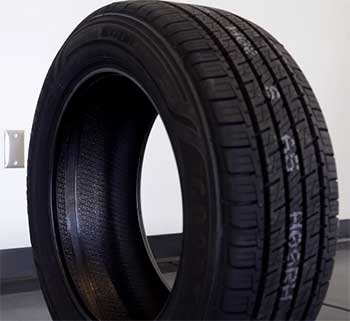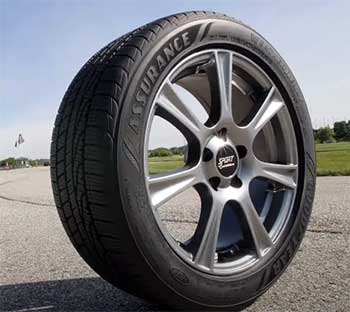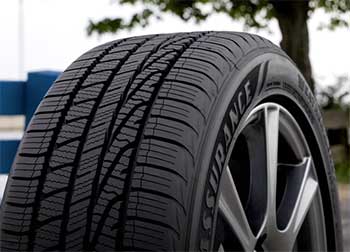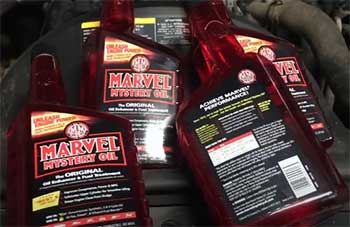If you’re in the market for new tires, you may be wondering whether to get the Goodyear Assurance All-Season or the Goodyear Assurance WeatherReady. Both are highly rated all-season tires from a top brand, but they have some key differences.
In this detailed comparison, we’ll look at the pros, cons, features, performance, and more to help you decide which tire is the better choice for your needs.
A Brief Comparison Table
| Feature | Goodyear Assurance All-Season | Goodyear Assurance WeatherReady |
| Type | All-season touring tire | All-weather touring tire |
| Snow & Ice Traction | Decent snow traction for light snow. Not optimized for ice/slush | Excellent snow traction with advanced siping. Shorter stopping distance on ice/slush |
| Wet Traction | Reliable wet handling and braking. Resists hydroplaning | Maximum wet traction and grip. Enhanced water evacuation |
| Dry Traction | Responsive steering and handling on dry roads | Nearly equal dry performance. Slightly less responsive than All-Season |
| Ride Comfort | Smooth, quiet ride. Good at isolating road noise | Equivalent plush, quiet ride quality |
| Treadlife | 65,000 mile warranty. Average of 60,000 miles | 65,000 mile warranty. Average of 60,000 miles |
| Price | $$ Affordably priced | $$$ 15-25% higher cost than All-Season |
Overview of the Goodyear Assurance All-Season Tire

The Assurance All-Season is Goodyear’s standard all-season touring tire. It’s designed to provide a smooth, quiet ride and reliable traction in most conditions.
Some of the key features of the Goodyear Assurance All-Season include:
- All-season tread design with lateral and longitudinal grooves to evacuate water and resist hydroplaning
- Silica-enhanced tread compound for wet grip and dry handling
- Comfortable ride with sound absorption
- 65,000-mile treadwear warranty
- Available in a wide range of sizes to fit sedans, coupes, crossovers, SUVs, and light trucks
The Assurance All-Season tire aims to deliver a balance of comfort, long tread life, and reliable traction across different weather conditions.
It’s a popular choice for drivers looking for a dependable, mainstream all-season tire.
Overview of The Goodyear Assurance WeatherReady Tire
The Assurance WeatherReady is Goodyear’s premium all-season touring tire designed for improved traction and handling in wet, snowy, and light winter conditions compared to a standard all-season tire.
Some standout features of the Goodyear Assurance WeatherReady include:
- Advanced all-season tread compound with maximum wet traction
- Aggressive tread design to eject slush and resist hydroplaning
- Grooves and sipes engineered to bite into snow and ice
- Snowflake symbol certifying severe snow performance
- 65,000-mile treadwear warranty
- Available in a wide range of sizes
Goodyear designed the Assurance WeatherReady for drivers who encounter frequent rain, snow, and changing weather but don’t want to swap out winter tires. It provides enhanced traction and grip when you need it most.
Also Read: Differences Between Pirelli P7 AS Plus 3 And Cinturato P7 Tires.
Differences Between Goodyear Assurance All-Season And WeatherReady Tires
Before diving into the comparison, it helps to understand the difference between all-season and all-weather tires.
All-season tires are designed to provide adequate traction in most conditions – dry roads, wet roads, light snow. They come with the iconic M+S marking for mud and snow.
All-weather tires take all-season capabilities a bit further. They meet the rubber industry’s severe snow rating and carry the 3 Peak Mountain Snowflake symbol. All-weather tires provide better snow and ice traction than a typical all-season.
The Goodyear Assurance All-Season is an all-season tire. The Assurance WeatherReady is classified as an all-weather tire due to its superior snow/ice capabilities.
- Tread Design and Traction

One of the biggest differences between the two tires is tread design, which impacts traction and grip.
The Assurance All-Season has a classic all-season tread pattern.
It has deep lateral grooves across the tread to channel water out from under the tire and minimize hydroplaning risk.
The large block tread elements promote a smooth ride on dry pavement.
In comparison, the Assurance WeatherReady features a more aggressive tread pattern to bite into snow and ice.
It has additional sipes (small slits) across the tread blocks to generate more biting edges.
The tire also has Z-shaped grooves along the shoulder to improve traction in turns when accelerating and braking in snowy conditions.
Winner: Goodyear Assurance WeatherReady
The WeatherReady’s advanced tread design provides markedly better traction and grip in snow, ice, and slushy conditions compared to the standard Assurance All-Season tire.
- Wet Traction and Hydroplaning Resistance
Drivers in areas with frequent rainfall also need to consider wet performance. How do these tires compare when it comes to moving water out from under the tires?
Both tires have grooves and channels engineered to effectively evacuate water and resist hydroplaning. However, the Assurance WeatherReady gains an edge with tread features like lateral notches and angled shoulder blocks that provide additional water evacuation compared to the All-Season tire.
The WeatherReady’s wet traction and grip is enhanced by Goodyear’s MaxTouch Construction, which uses a closed outside shoulder to maximize the tread surface in contact with the road. This generates more traction in wet and slippery conditions.
Winner: Goodyear Assurance WeatherReady
While both offer solid wet performance, the WeatherReady tire is engineered to channel away more water and provide maximum wet contact for shorter braking distances on damp roads.
- Dry Road Handling and Braking
Many buyers prioritize a tire’s performance on dry pavement since that’s where most everyday driving occurs. Let’s look at how the All-Season and WeatherReady tires handle on warm, dry roads.
The Assurance All-Season provides responsive handling and steering on dry roads. The large tread blocks remain stable under cornering forces.
Goodyear also tuned the tire’s internal structure to dampen vibrations for a comfortable, quiet ride. While not a performance tire, the All-Season delivers pleasing grip under everyday driving conditions.
The Assurance WeatherReady also focuses on stable, even treadwear and a comfortable ride quality. The aggressive tread pattern doesn’t compromise dry road manners. However, the All-Season has a slight edge for responsive steering feel and braking on warm, dry roads where traction is plentiful.
Winner: Goodyear Assurance All-Season
While the margin is narrow, the All-Season tire takes the win for crisper handling and braking on dry roads compared to the WeatherReady. However, both perform well for typical driving needs.
- Ride Comfort
Beyond traction and grip, ride quality matters too. You want tires that don’t transmit road noise and vibration into the cabin.
The Assurance All-Season provides a plush, quiet ride thanks to its noise-reducing tread design and internal insulation. It smooths out imperfections in the road surface and isolates road noise.
Similarly, the Assurance WeatherReady focuses on ride comfort using Noise Block Technology. The tires absorb vibration and sound waves for a quiet ride. The advanced tread compound also dampens noise levels.
For ride quality, the tires are nearly identical. Both earn excellent marks for cushioning bumps and minimizing road noise intrusion.
Winner: Tie
There is no discernible difference in ride comfort and interior quietness between the All-Season and WeatherReady options.
Also Read: How Goodyear ComforTred And ComfortDrive Tires Stack Up?
- Treadlife and Durability
To get the most out of your tire purchase, you want an option with a long treadlife. Tires that wear out quickly mean you must purchase replacement tires more often.
Goodyear outfits both the Assurance All-Season and Assurance WeatherReady with a 65,000-mile treadwear warranty when installed as new tires on new vehicles. For replacement tires, the treadwear coverage is 45,000 miles.
Real world treadlife depends on your driving habits and road conditions. However, you can expect to get a similar lifespan out of both tire models – around 50,000 to 70,000 miles for the average driver.
The Assurance All-Season may see slightly longer treadwear on warm, dry roads. But the difference is negligible between the two. They both achieve long mileage thanks to Goodyear’s durable tread compounds and sturdy construction.
Winner: Tie
You can expect comparable long-lasting treadlife from both the All-Season and WeatherReady tires.
- Pricing

The final consideration for most shoppers is cost and value. You want capable tires at a reasonable price.
As Goodyear’s standard all-season touring tire, the Assurance All-Season has a slightly lower price point.
On average, you’ll pay around $130-$170 per tire depending on size.
The Assurance WeatherReady is categorized as a premium tire.
The advanced tread features equate to a higher price – around $160-$220 per tire on average.
Overall, the WeatherReady costs 15-25% more per tire compared to the All-Season option. This pricing gap is typical when stepping up to a tire with more robust capabilities.
In terms of value, the extra cost may be worthwhile if you frequently drive in wintry conditions and want maximum traction and grip. But for primarily dry climate drivers, the Assurance All-Season provides pleasing performance at a lower price point.
Winner: Goodyear Assurance All-Season
The standard All-Season tire wins out for shoppers focused on value and budget. But the WeatherReady is worth the extra investment if snow and ice traction are priorities.
Key Takeaways: All-Season And WeatherReady
Here are some of the essential takeaways when comparing the Goodyear Assurance All-Season and Assurance WeatherReady tires:
- The WeatherReady has vastly superior snow and ice traction thanks to its advanced tread pattern and siping. It’s the clear winner for winter weather capability.
- Both tires deliver strong wet performance and hydroplaning resistance. But the WeatherReady tire has the edge in wet handling and braking.
- For warm, dry conditions, the All-Season tire provides a slight advantage in responsive steering and braking. But the margin is narrow.
- Ride quality is similarly plush and quiet between the two options. No clear winner.
- Treadlife expectancy is long for both tires, around 50,000+ miles for the average driver. A tie.
- The Assurance All-Season costs less than the premium WeatherReady tire. An important consideration for budget-focused buyers.
Overall, the Goodyear Assurance WeatherReady is the best option if you regularly drive in snow, ice, heavy rain, and fluctuating conditions. The enhanced traction is worth the higher price.
But for drivers in temperate climates who log most miles on warm, dry roads, the Assurance All-Season provides reliable performance at a more affordable price point.
Either way, you can trust Goodyear to deliver a safe, comfortable ride across the miles.
Also Read: Comparison of Goodyear And Starfire Tires.
Frequently Asked Questions (FAQ)
While often classified as all-season, the Assurance WeatherReady is technically an all-weather tire. This means it goes beyond typical all-season capabilities to provide enhanced traction in snowy and icy conditions.
Yes, the Assurance WeatherReady is an excellent tire for snowy conditions. The aggressive tread with extra siping grips snow-covered roads and provides shorter stopping distances. It’s one of the best tires in its category in snow and ice.
Yes, the Assurance WeatherReady utilizes noise-reducing technology so it runs quiet. The tire absorbs noise and vibration for a peaceful ride quality.
The standard Goodyear Assurance tire line is classified as all-season. But the Assurance WeatherReady model is engineered as an all-weather tire, meaning it has better snow and ice traction than a typical all-season.
The Verdict: Which Tire Is Right For You?
In the battle of the Goodyear Assurance All-Season vs the Goodyear Assurance WeatherReady, there’s no universally “best” option. The right tire depends on your driving needs and weather conditions.
Buy the Assurance All-Season if:
- You live in a mild climate with minimal snow and ice
- You want maximum value from your tire purchase
- You prioritize responsive dry handling and steering feel
Buy the Assurance WeatherReady if:
- You regularly drive on snow, ice and slushy roads
- You need strong wet weather and hydroplaning resistance
- You’re willing to pay extra for winter weather capability
For most drivers, the Assurance All-Season hits the sweet spot of dependable performance, long treadlife, and reasonable cost. But upgrading to the Assurance WeatherReady is a smart investment if you want best-in-class traction for changing weather.
Either way, you can trust Goodyear to get you where you need to go with confidence and peace of mind.

